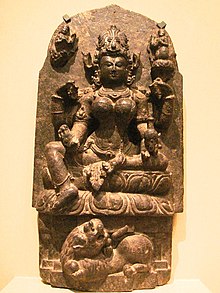
A goddess is a female deity. In many known cultures, goddesses are often linked with literal or metaphorical pregnancy or imagined feminine roles associated with how women and girls are perceived or expected to behave. This includes themes of spinning, weaving, beauty, love, sexuality, motherhood, domesticity, creativity, and fertility. Many major goddesses are also associated with magic, war, strategy, hunting, farming, wisdom, fate, earth, sky, power, laws, justice, and more. Some themes, such as discord or disease, which are considered negative within their cultural contexts also are found associated with some goddesses. There are as many differently described and understood goddesses as there are male, shapeshifting, or neuter gods.

The sky often has important religious significance. Many religions, both polytheistic and monotheistic, have deities associated with the sky.

Fertility in art refers to any artistic work representing or portraying fertility, which usually refers to successful breeding among humans, although it may also mean successful agriculture and animal husbandry. It includes engravings, drawings, paintings, sculptures, figurines, portraits and even literary works. In Paleolithic art, fertility is usually associated with figurines with exaggerated parts of human anatomy.

A weather god or goddess, also frequently known as a storm god or goddess, is a deity in mythology associated with weather phenomena such as thunder, snow, lightning, rain, wind, storms, tornadoes, and hurricanes. Should they only be in charge of one feature of a storm, they will be called after that attribute, such as a rain god or a lightning/thunder god. This singular attribute might then be emphasized more than the generic, all-encompassing term "storm god", though with thunder/lightning gods, the two terms seem interchangeable. They feature commonly in polytheistic religions, especially in Proto-Indo-European ones.

Songzi Niangniang, also referred to in Taiwan as Zhusheng Niangniang (註生娘娘), is a Taoist fertility goddess. She has been identified with many historical figures. She is often depicted as Guan Yin herself in drawings, or alternatively as an attendant of Guan Yin; Guan Yin herself is also often referred to as "Guan Yin Who Brings Children". She is depicted as an empress figure, much like Xi Wangmu and Mazu. She is often portrayed as an attendant to Bixia Yuanjun.

A liminal deity is a god or goddess in mythology who presides over thresholds, gates, or doorways; "a crosser of boundaries". These gods are believed to oversee a state of transition of some kind; such as, the old to the new, the unconscious to the conscious state, the familiar to the unknown.

Chinese gods and immortals are beings in various Chinese religions seen in a variety of ways and mythological contexts.

Fertility was often mentioned in many mythological tales. In mythology, fertility deities exist in different belief systems or religions.











